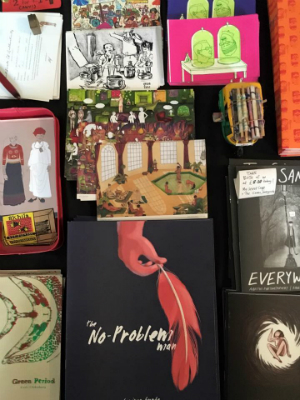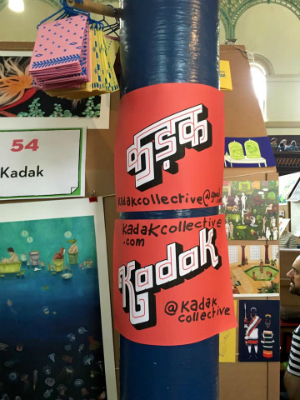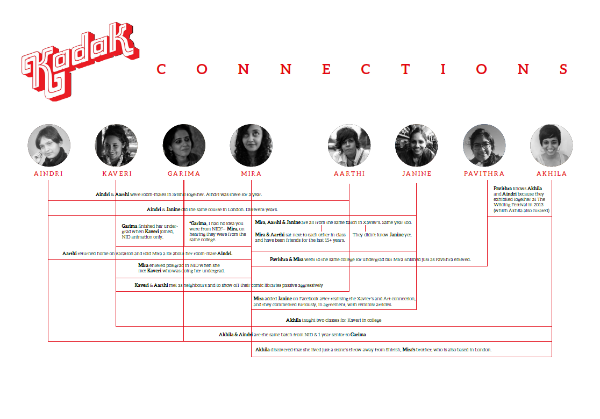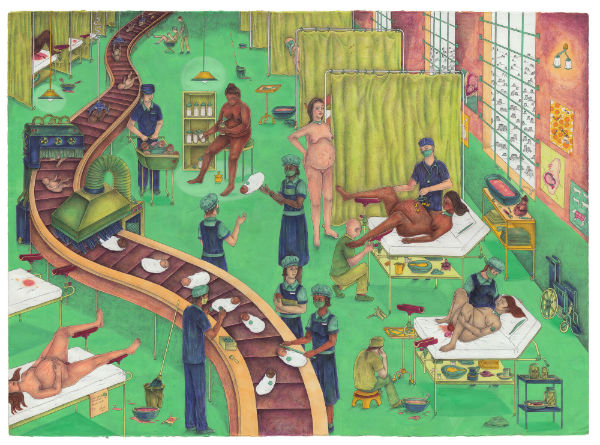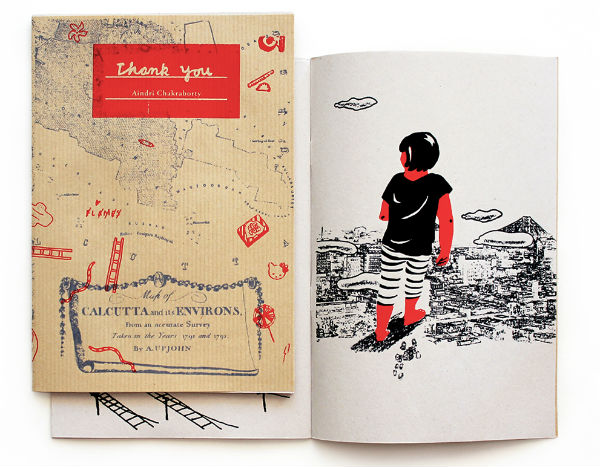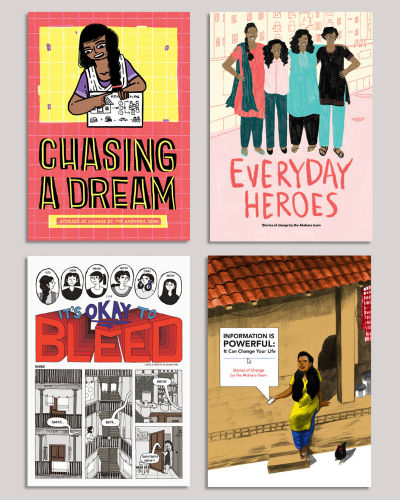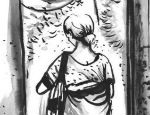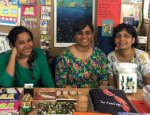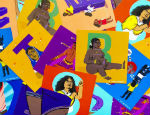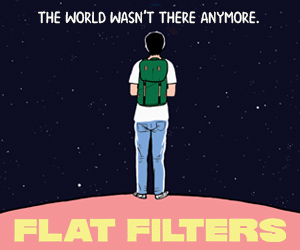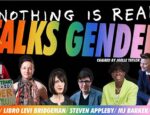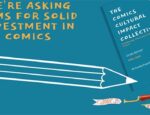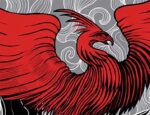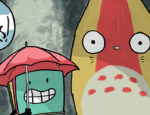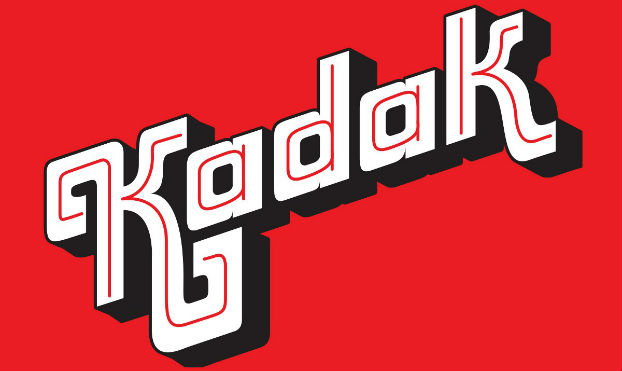
Throughout this week at Broken Frontier we have been chatting with and exploring the work of the South Asian women artists who make up the Kadak Collective. Over the last two days we’ve looked at the individual practice of their members Aindri Chakraborty, Mira Malhotra, Aarthi Parthasarathy, Kaveri Gopalakrishnan, Janine Shroff, Pavithra Dikshit, Garima Gupta, Laydeez do Comics Prize-shortlisted Akhila Krishnan and Kadak collaborator Valentino Vecchietti.
If you haven’t caught up with the series yet then you can read Part 1 here and Part 2 here.
In the final instalment today we talk with some of the group about Kadak’s genesis, its ethos and what the future holds for the collective…
The Kadak table at ELCAF in 2016
How did you all become a part of Kadak and how would you describe the aims of the collective?
AKHILA KRISHNAN: The collective came together around the time applications for ELCAF 2016 opened, and we have gone on to do a few commissions (for the Goethe Institute, the Gaysi Zine, Akshara etc.) together. We’re constantly evolving and refining our aims – we use online and digital shared spaces (Whatsapp, Google Drive etc.) to talk and make work and I think this approach is quite unique. We’re also a support network for each other and working together has been really enriching. I think the hope is that we expand and grow; we’re currently testing that and seeing what it means for the way in which we currently work.
Most of us have ‘day’ jobs apart from our work with Kadak – so the past few years have also been about feeling out how to balance both these parts of our practice. We’ve written a few pitches for work that have not worked out, but my personal hope is that we are able to find the funding to create those ideas ourselves rather than do them as part of a commission only. One of them involves crowd-sourcing stories and personal experiences and weaving them into a larger publication – which is a big area of interest for me, I hope we can find a way to make that happen. That’s the hope for the future.
MIRA MALHOTRA: Kadak came out of a need for more representation for women in this niche area of South Asian women in visual narratives. We all knew each other partially or had followed each others work before; we even have a diagram (above) that shows our connections prior to Kadak.
We all work remotely and individually, but on common themes, and the online groups we have serve as forums where we can discuss, bounce off ideas and collaboratively publish to amplify our voices. We all have independent practices (bread and butter work) apart from Kadak; we use Kadak only to talk about stuff we otherwise have no opportunity for. Making work is not the only focus to Kadak. It’s not always result-oriented, which I like, it’s more about dialogue, conversation and the journey. In fact recently, Aarthi and I were both a part of a panel on graphic storytelling in India at this year’s Design Fabric Festival.
More of Janine’s powerful illustrative work in ‘The Breeders’
JANINE SHROFF: As the others have mentioned, the collective was formed around the time of the ELCAF. Aindri and Akhila conceived of the idea of all of us sharing a table, and it was immediately exciting. Illustration (or zine-making or painting), can be quite isolated practices sometimes so besides representing South Asian artists it is also nice to have a support network of fellow artists and possible collaborators. I hadn’t met any of the others in the collective but I knew of them or their work for some years. We’ve gone on to do a few collabs since then, Gender Bender, a small ‘Kadak zine’ and featured in BOLD, an exhibition of South Asian design at the Rich Mix, during Design week.
Kadak doesn’t have a hard set of aims, and is fairly democratic. We currently range across continents; Asia, Europe and the US. So most of our collaborations and discussions happen digitally via Whatsapp or group gchats and google drive to initiate discussions or organise projects. One of Kadak’s current goals, besides hopefully squeezing in more collabs between (as Mira says) bread and butter work, is to expand it to include more individual groups like this, setting up individual, independent chapters of other South Asian women artists.
Aindri’s Thank You zine
AINDRI CHAKRABORTY: Kadak does not have a TedX style origin story. For me it happened as a response to the lack of diversity and inclusion for women and other communities in comic fairs and fests. It happened so a bunch of us could afford a table together and help each other out. It has become a sort of whisper network, collaborative space and incubator.
I want to decenter Kadak and invite other artists, especially from communities we have overlooked when we started, to lead and shape Kadak as we go along. This is currently in process.
Kadak is going to be tabling at LA Zine Fest this May with Anjora Noronha, Nausheen Javed, Supernova Design and Jamie Tan as part of the team. We recently completed a set of comics (below) with NGO Akshara Center, Mumbai with artists Shreyas Krishnan and Kruttika Susarla. Hopefully there’s more commissions and book fests in the future.
VALENTINO VECCHIETTI: I have been friends with Janine for quite a few years, and heard about Kadak as they were forming. I came along to a Woman of the World festival event that they were presenting at, and met some of the other members: all wonderfully inspiring and talented people with powerful messages. Soon after that I went along to the ELCAF event in 2016 and it was then that Aindri asked if I would collaborate on a comic, which became IN-OUT: Gender Through the Brexit Lens, for Gender Bender 2016 Bangalore. I am very happy to be a Kadak Collective collaborator, and I look forward to future projects.
AARTHI PARTHASARATHY: Yes, moving forward, we’d like to expand and decentralize it, do more work – commissions, zines, publications hopefully and never lose sight of diversity, representation and empathy along the way.
For more on the Kadak Collective visit their site here and you can see much more of the work in discussion here at their reading room on Medium (with store links where available). You can alos follow the Kadak Collective on Instagram here.
For regular updates on all things small press follow Andy Oliver on Twitter here.





